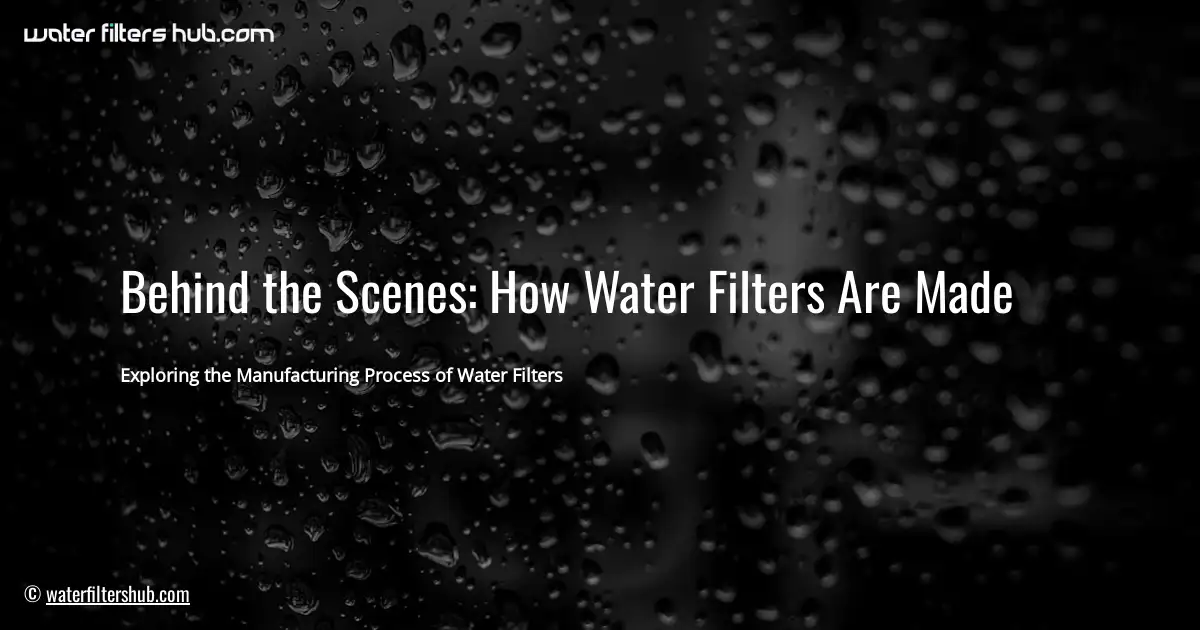Exploring the Manufacturing Process of Water Filters
Water is the elixir of life, and access to clean water is a fundamental human right. Unfortunately, many people around the world lack access to safe drinking water, exposing them to waterborne diseases and other health risks. Water filters play a crucial role in improving water quality, removing contaminants and ensuring that water is safe to drink.
“Water is the driving force of all nature.” – Leonardo da Vinci
Water filters work by trapping contaminants in a filter media, such as activated carbon or ceramic. These filters can remove a wide range of contaminants, including bacteria, viruses, heavy metals, and chemicals. By using water filters, we can protect ourselves and our loved ones from waterborne illnesses and ensure that we have access to clean, safe drinking water.
| Contaminant | Health Effects |
|---|---|
| Bacteria | Diarrhea, vomiting, cramps |
| Viruses | Flu, colds, hepatitis |
| Heavy metals | Lead poisoning, kidney damage |
| Chemicals | Cancer, reproductive problems |
“Water is life’s matter and matrix, mother and medium. There is no life without water.” – Albert Szent-Gyorgyi
Water filters are an essential tool for improving water quality and protecting our health. By understanding how water filters are made, we can make informed decisions about the filters we use and ensure that we have access to clean, safe drinking water.
Understanding Water Filtration 💦
Role of Water Filters 💧
Water filters play a crucial role in improving water quality by removing harmful contaminants. They act like a shield, protecting us from bacteria, viruses, and other impurities that can compromise our health. Just as a knight in shining armor fends off invaders, water filters guard our water supply, ensuring we have access to clean and safe drinking water. 🛡️
Different types of water filters use various methods to trap and remove contaminants. Some, like activated carbon filters, use adsorption to capture impurities. Others, like reverse osmosis systems, employ a sophisticated membrane to filter out even the tiniest particles. 🔬
The materials used in water filter manufacturing play a pivotal role in determining the efficiency and durability of the filter. Manufacturers carefully select these materials based on specific criteria:
| Material | Criteria |
|---|---|
| Activated Carbon | High adsorption capacity for contaminants like chlorine, pesticides, and heavy metals |
| Ceramic | Fine pores for removing bacteria, viruses, and sediment |
| Reverse Osmosis Membranes | Semi-permeable barriers that remove dissolved ions, salts, and minerals |
These criteria ensure that the materials effectively remove contaminants while maintaining structural integrity and longevity. Just as a chef carefully selects ingredients to create a delicious meal, water filter manufacturers meticulously choose materials to craft filters that deliver pristine water.
The heart of any water filter lies in its filter cartridges or membranes. These components are meticulously engineered to remove specific contaminants from water. Activated carbon cartridges, like tiny sponges, trap organic pollutants and chlorine. Ceramic filters, with their porous structure, physically block bacteria and sediment. Reverse osmosis membranes, the ultimate barrier, employ a semi-permeable barrier to separate dissolved solids and heavy metals.
Each component is produced with precision. Activated carbon is heated to create a highly porous surface area, maximizing its adsorption capacity. Ceramic filters are molded and fired at high temperatures, ensuring their strength and durability. Reverse osmosis membranes are fabricated using advanced polymer technology, resulting in ultra-fine pores that allow only water molecules to pass through.
The machinery and techniques employed in component production are as diverse as the materials themselves. Automated machines precisely cut and shape filter cartridges, ensuring a consistent fit. Robotic arms delicately assemble ceramic filters, layer by layer. Reverse osmosis membranes are spun using a technique similar to making cotton candy, creating a thin and efficient barrier.
The result of this intricate process is a symphony of components, each playing a vital role in the purification of water. From the humble activated carbon granules to the high-tech reverse osmosis membranes, every element is carefully crafted to provide us with the clean and safe water we rely on every day.
Assembly and Testing 🔧
Assembling water filters is a critical step that demands precision and attention to detail. Each component must fit together seamlessly to ensure proper filtration and functionality. After assembly, rigorous testing procedures are conducted to verify the filter’s performance and compliance with industry standards. These tests evaluate the filter’s ability to remove specific contaminants, such as bacteria, sediment, and heavy metals. They also assess the filter’s flow rate, pressure drop, and durability.
Imagine a water filter as a team of superheroes, each component playing a vital role in protecting your water from contaminants. The assembly process is like putting together a puzzle, where every piece must fit perfectly to create a cohesive unit. And just like superheroes undergo rigorous training, water filters are subjected to a battery of tests to ensure they’re ready to battle against waterborne threats.
| Test | Purpose |
|---|---|
| Contaminant Removal Efficiency | Verifies the filter’s ability to remove specific contaminants. |
| Flow Rate | Measures the rate at which water flows through the filter. |
| Pressure Drop | Assesses the pressure loss across the filter. |
| Durability | Evaluates the filter’s ability to withstand repeated use and harsh conditions. |
Compliance with industry standards, such as NSF International and WQA, is crucial to ensure that water filters meet the highest quality and safety requirements. These standards set strict guidelines for materials, performance, and testing. By adhering to these standards, manufacturers demonstrate their commitment to providing consumers with safe and effective water filtration solutions.
HOW WATER FILTERS ARE MADE ON YOUTUBE
Packaging and Distribution 📦🚚
The journey of water filters doesn’t end at the assembly line. Once they’re ready, they embark on a new adventure: getting into your hands! 🚚
Packaging plays a crucial role in protecting these delicate devices from the bumps and bruises of transportation. Like a cozy blanket, it shields them from harm. And just like a well-wrapped gift, it keeps them clean and pristine until they reach their destination.
Distribution is the final leg of the journey, where water filters find their way to homes, businesses, and communities. It’s like a relay race, with each step bringing them closer to their mission of providing clean water.
Whether it’s through online retailers, local stores, or direct distribution, water filters make their way to the people who need them most. It’s a seamless process that ensures everyone has access to the gift of pure, refreshing water. 💧
Quality Control and Certification 🏆
Ensuring Reliability and Performance
Water filters play a crucial role in safeguarding our health, so it’s paramount that they meet the highest standards of quality. Manufacturers implement rigorous quality control measures throughout the manufacturing process to ensure the reliability and performance of their products. This includes:
- Thorough Inspections: Each component and assembled filter undergoes meticulous inspections to detect any defects or inconsistencies.
- Performance Testing: Filters are subjected to stringent testing to verify their filtration efficiency, capacity, and durability.
- Compliance with Standards: Manufacturers adhere to industry standards and regulations to guarantee that their filters meet or exceed established performance criteria.
- Third-Party Certifications: Independent organizations, such as NSF International and WQA, certify water filters that meet their rigorous standards for safety and effectiveness.
Environmental Considerations ♻️
Water filter manufacturing can have an impact on the environment. The production of raw materials, such as activated carbon, can involve mining and processing, which can lead to environmental degradation. Additionally, the disposal of used water filters can also pose environmental challenges.
To minimize the environmental impact, manufacturers are exploring sustainable practices and materials. For example, some companies are using recycled materials in the production of water filters. Others are developing biodegradable filters that can be safely disposed of without harming the environment.
By choosing water filters that are made from sustainable materials and disposed of responsibly, we can help to protect our planet while enjoying the benefits of clean and safe drinking water.
Advancements and Innovations 💡
The world of water filtration is constantly evolving, with cutting-edge technologies emerging to enhance the efficiency and convenience of water purification. Nanotechnology, in particular, is making waves in this field. Imagine tiny particles, a million times smaller than a human hair, being used to create highly porous membranes that can trap even the smallest contaminants. These nanomembranes allow for faster filtration rates, higher contaminant removal capacity, and longer filter life.
But it doesn’t stop there. Smart filtration systems are also revolutionizing the way we interact with water filters. These systems use sensors and microprocessors to monitor water quality in real-time, adjusting filtration settings and providing notifications when it’s time to replace the filter. They can even connect to your smartphone, giving you remote access to water quality data and filter status.
With these advancements, water filtration is becoming more efficient, convenient, and personalized than ever before. It’s like having a water purification expert in your home, working tirelessly to ensure you have access to the cleanest and safest drinking water possible.
Conclusion
The Importance of Clean Water
Water is the elixir of life, sustaining our bodies and nourishing our souls. Yet, access to clean and safe drinking water remains a global challenge. Water filters play a crucial role in purifying water, removing harmful contaminants and ensuring our well-being.
Understanding the manufacturing process of water filters empowers us to make informed choices about the quality of water we consume. From the selection of raw materials to rigorous testing and certification, every step in the process is meticulously designed to deliver pure and refreshing water to our homes and businesses.
As we navigate the complexities of modern life, let us not forget the importance of clean water. Water filters are our guardians, ensuring that the lifeblood of our planet is safe and accessible for generations to come.
“Water is the driving force of all nature.” – Leonardo da Vinci
WATER FILTRATION – AN OVERVIEW | SCIENCEDIRECT TOPICS
STUDENT PROJECT: MAKE A WATER FILTER | NASA/JPL EDU
HOW TO CLEAN WATER FILTER BRITA
HOW LONG DO BERKEY WATER FILTERS LAST
WHAT WATER FILTERS REMOVE BACTERIA
HOW OFTEN DO WATER FILTERS NEED TO BE CHANGED
HOW TO CHANGE APEC WATER FILTERS







Leave a Reply